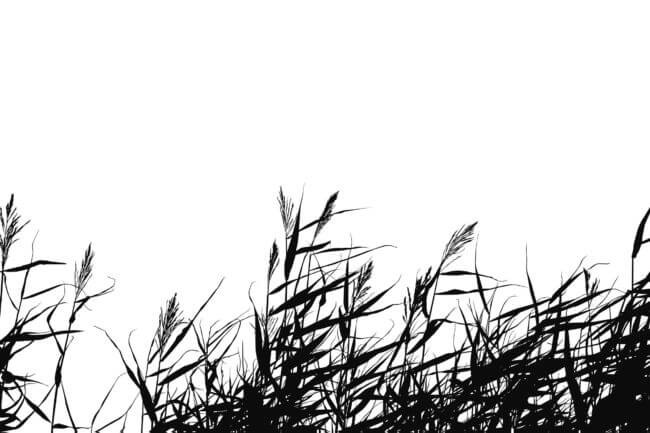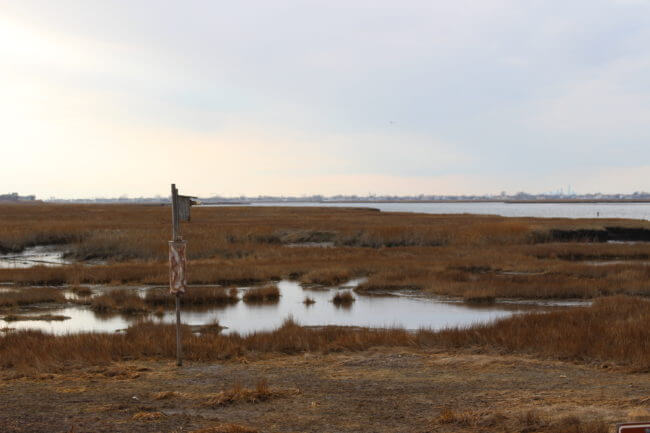Some of the best fishing on the Striper Coast takes place in the skinny waters of the salt marsh. These labyrinths of unassuming meadows and sinuous creeks hide an environ of never-ending decay and genesis. As the water recedes, you can catch the telltale odor of expired life. But further examination reveals the beginnings of existence springing forth from that odiferous muck. Marshes act as nurseries for many species of game fish and prey alike. Everything from Atlantic menhaden to weakfish begin their life cycles amongst the flora that comprise these islands. It is this vegetation that allows these atolls to exist, their roots binding the soil against the corrosive action of wind and tide. Invertebrates can be found in abundance as well; from the mollusks so familiar at local markets and restaurants to benthic worms that provide an all-you-can-eat buffet for stripers when the moon urges them to hatch in droves. It is this smorgasbord of bite-sized offerings that draws predators out of the relative safety of deeper water.
Originally appeared in Tail 34 – March/April 2018
By Joseph Albanese
This habitat can provide some of the best angling you are likely to encounter in the northeast, but there are some stars that need to align for that to happen. As the water is shallower, everything is magnified. The tidal stage, position and intensity of the sun, and even the color and composition of the bottoms’ importance is exaggerated. Typically, cordgrass is found in the low-lying areas and salt hay in the high marsh, providing cover for the young-of-the-year to grow. The exposed grasses offer overhead cover from terns, gulls, and wading birds. The emergent stalks afford crevices in which to hide from finned predators. But this protection is far from perfect, with certain conditions conspiring to leave these hapless creatures exposed. When this happens, the combination of bait and predators leads to a feeding frenzy of epic proportions. When these variables all line up, there is lights out fishing for hungry migratory striped bass.
 I have found the magic number to be 64 degrees. The fishing has broken wide open when the water temperature hits that number, according to my logs. It seems to be just warm enough to stimulate their metabolism, but not warm enough to make them sluggish. The action seems to be white hot until the temperature hits 70 or so, although you can continue to catch fish in the back when periods of high tide coincide with dawn and dusk. There are usually a few days a month that can be productive even in the warmest months. You want to take advantage of the tail of the flood tide in the height of summer; those ocean currents bring in cooler water with gamefish floating in along with them. Fortunately, bluefish don’t mind these warmer temps, and can keep rods doubled over when the stripers are on a heat-induced hiatus.
I have found the magic number to be 64 degrees. The fishing has broken wide open when the water temperature hits that number, according to my logs. It seems to be just warm enough to stimulate their metabolism, but not warm enough to make them sluggish. The action seems to be white hot until the temperature hits 70 or so, although you can continue to catch fish in the back when periods of high tide coincide with dawn and dusk. There are usually a few days a month that can be productive even in the warmest months. You want to take advantage of the tail of the flood tide in the height of summer; those ocean currents bring in cooler water with gamefish floating in along with them. Fortunately, bluefish don’t mind these warmer temps, and can keep rods doubled over when the stripers are on a heat-induced hiatus.
Light is also important. In the dog days of summer, the noonday sun is almost sure to chase predatory fish to the sanctuary of deep water. The early season is an entirely different animal though, as water temperatures haven’t reached their seasonal peaks. Referring back to the magnifying effect of the shallow early season waters, temperature can change as much as ten degrees in a day, depending on the timing of the colder ocean waters rushing in. And no matter the month, nighttime is the right time. Gamefish, and stripers especially, take advantage of the light-gathering potential of their larger eyes and feed nocturnally. This feeding occurs at all phases of the moon, but I have had the best luck on the new and full. The new moon always seems to outperform the full, even though both have an equal effect on tidal heights. I can only hypothesize that the darkness afforded by the absence of the moon makes predators more reliant on other senses and they strike more often as a result.
Earlier I mentioned the substrate—that wasn’t for effect. As oyster and other mollusk shells decompose, they turn into a fine, dark sediment that combines with the existing bottom. This creates a dark mud that absorbs light energy more effectively than a sand bottom, or even a lighter colored mud bottom. These areas will heat up faster than the surrounding earth, and can be the first hotbed of activity in the early season. This knowledge can be used to the angler’s advantage when prospecting for areas of ideal temperature. Early in the spring, before the turbidity caused by boat propellers and the algae blooms of summer, visibility and therefore light penetration is good. Noting these areas is important, as early in the season a few yards can mean all the difference.
In stark contrast to the deeper waters of the Atlantic proper, most salt marshes are shallow; averaging four to six feet on all but the steepest of tides. As such, stealth is the key. You may be able to get away with a blaring radio in 90 feet of water, but that has no place in the marsh. Even the simple act of dropping something on deck can be enough to put the fish down. Your approach should be as cautious as possible, coming off plane well in advance of the area you plan to fish. If possible, turn your motor off without shifting out of gear and drift into place, as the clunking of your boat’s transmission is a proven way to scare fish. If you have a trolling motor or push pole, this is definitely the time to use it. Likewise, wading anglers will also benefit from a healthy dose of creep. While you don’t need the same surreptitious approach that is required by wary trout in chalk streams, you will benefit from some sneak, trying not to crush shells underfoot or dislodge clumps of dirt. Just be careful, as the mud seems bottomless in spots.
Tide stage is of the utmost importance. Someone once said there are two good times to go fishing: when it’s raining and when it’s not. This is true to a degree; you can’t catch them on the couch and you have to make the most of your opportunities. But to put up big numbers in the marsh, you need to time the tide almost perfectly. I have found that under most circumstances, the best time to fish the salt meadows is an hour before the peak of high, staying until you run out of water. The exception to this rule is a moon tide, when the water rises far enough above the grass that the stripers are no longer confined by the channel edges and can fan on top of usually dry grass in pursuit of baitfish. This is not to say you won’t pick up a fish here and there, you just won’t connect like you will when the high marsh starts to drain, concentrating food sources in the deeper channels as the creeks empty.
 While most of these fish will be in the 22- to 32-inch class, there are opportunities to tangle with some truly outsized bruisers in single-digit depths. You should match your tackle to the size of the fish you’ll likely encounter, with a little extra backbone in case you do battle with a heavyweight. While you’re not dealing with rocks or bridge abutments, there are plenty of structures for fish to break you off on: old pilings, pieces of scuttled vessels, and any number of manmade objects conspiring to break your line. A nine or 10-weight will serve you well, as they can punch bulky poppers into a headwind and have enough oomph if you do happen to find yourself connected to a larger specimen. This is an instance where you will want a reel with a solid drag. I used a Pflueger Medalist for years, applying pressure to the spool to stop extended runs, but the abundance of sealed-drag reels on the market negates the need for such practices. As the water is shallow here, a floating line is best, but a slow-sinking intermediate will work. I used to bother with tapered leaders, but no longer. I run six to 10 feet of 15-pound fluorocarbon. If the fish are finicky, I’ll tie my own leader with a six-foot butt of 15-pound and a three-foot tippet of eight or 10 pounds.
While most of these fish will be in the 22- to 32-inch class, there are opportunities to tangle with some truly outsized bruisers in single-digit depths. You should match your tackle to the size of the fish you’ll likely encounter, with a little extra backbone in case you do battle with a heavyweight. While you’re not dealing with rocks or bridge abutments, there are plenty of structures for fish to break you off on: old pilings, pieces of scuttled vessels, and any number of manmade objects conspiring to break your line. A nine or 10-weight will serve you well, as they can punch bulky poppers into a headwind and have enough oomph if you do happen to find yourself connected to a larger specimen. This is an instance where you will want a reel with a solid drag. I used a Pflueger Medalist for years, applying pressure to the spool to stop extended runs, but the abundance of sealed-drag reels on the market negates the need for such practices. As the water is shallow here, a floating line is best, but a slow-sinking intermediate will work. I used to bother with tapered leaders, but no longer. I run six to 10 feet of 15-pound fluorocarbon. If the fish are finicky, I’ll tie my own leader with a six-foot butt of 15-pound and a three-foot tippet of eight or 10 pounds.
As far as flies go, I prefer top water stuff. Nothing is more exciting than watching a 30-inch fish smash a hunk of feathers being pulled across the surface. The Gartside Gurgler is a fantastic choice, as it moves a ton of water and is very easy to cast. Hard-body poppers are a close second, with deer hair divers also in the mix. I don’t often use subsurface flies, but I will throw a crab pattern every now and then. These are particularly useful dead-drifted in the earliest part of the season, as the naturals are lethargically emerging from the mud and other bait types haven’t arrived yet. Clouser minnows and deceivers are also good choices, but I only resort to them when I know fish are around but I can’t coax them to the surface. Toss Clousers when thin-profile baits such as sand eels and spearing are present, turning to Deceivers when wider species such as menhaden dominate the forage base. As far as retrieves go, I always start gentle. If finesse doesn’t produce, I’ll ratchet it up a bit, creating louder pops. Don’t be afraid to cast to the same spot a few times, sometimes you can get an aggravated strike from a fish that may not like your fly.
The shoulder seasons of the spring and the fall are ideal for cashing in some explosive fishing in these exciting expanses of water interspersed with grassy shoals. Most of the pleasure boaters haven’t put their boats in yet, or have already taken them out, so you’ll have some solitude. There may be some additional challenges posed by the shallow depths, but the rewards are made just that much sweeter. Sixty fish tides are well within the realm of possibility with a little bit of planning and forethought. Take care to note the conditions, and make your fishing plans accordingly. You may have to use a sick day; time and tide wait for no man, as the old truism notes. If you can line up all of these variables, you can take part in some of the best fishing you’ll likely experience—or at least some of the most exciting. Fair winds and tight lines.
Subscribe to Tail – 6 Issues for $34.99



